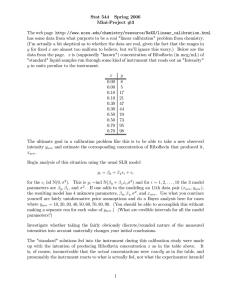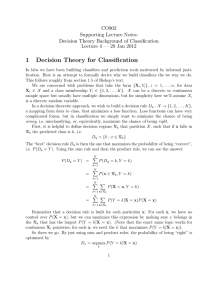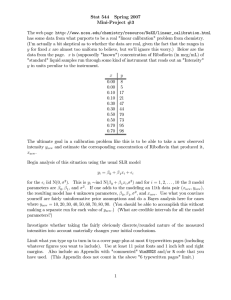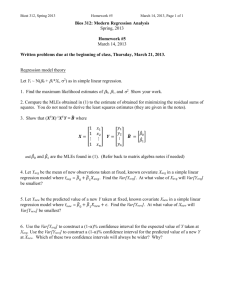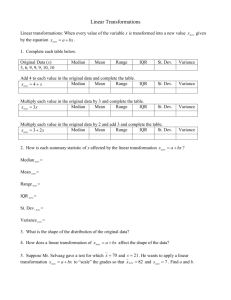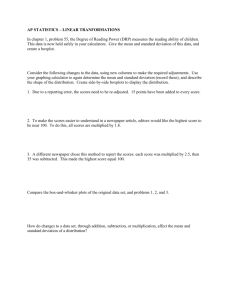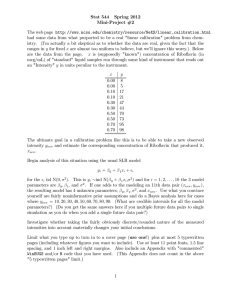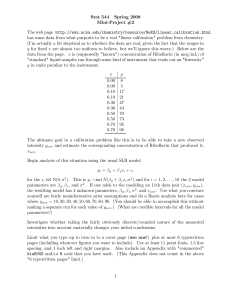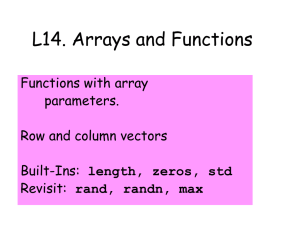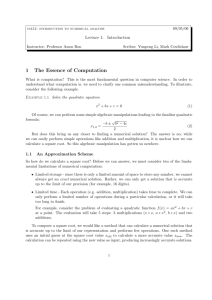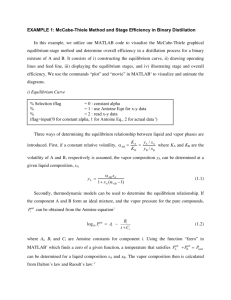A Note on Bayes Simple Linear Calibration
advertisement
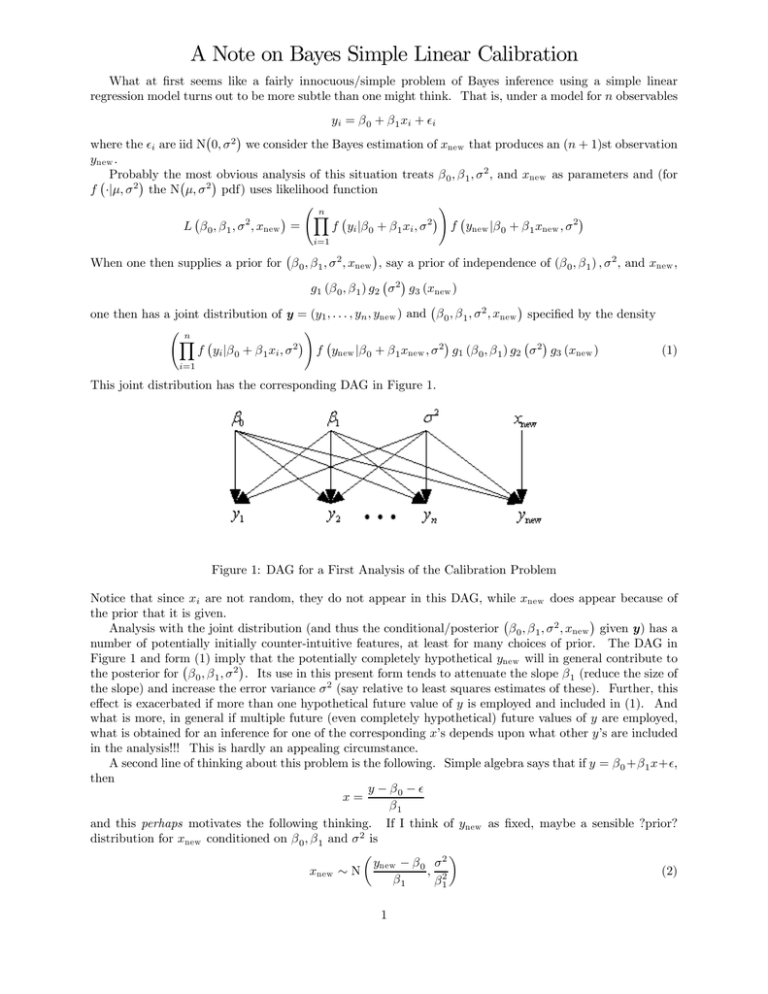
A Note on Bayes Simple Linear Calibration What at first seems like a fairly innocuous/simple problem of Bayes inference using a simple linear regression model turns out to be more subtle than one might think. That is, under a model for n observables yi = β 0 + β 1 xi + i ¡ ¢ are iid N 0, σ 2 we consider the Bayes estimation of xnew that produces an (n + 1)st observation where the i ynew . the¡most¢obvious analysis of this situation treats β 0 , β 1 , σ 2 , and xnew as parameters and (for ¡ Probably ¢ 2 f ·|μ, σ the N μ, σ 2 pdf) uses likelihood function Ãn ! Y ¡ ¢ ¢ ¡ ¢ ¡ 2 2 f ynew |β 0 + β 1 xnew , σ2 f yi |β 0 + β 1 xi , σ L β 0 , β 1 , σ , xnew = i=1 ¡ ¢ When one then supplies a prior for β 0 , β 1 , σ2 , xnew , say a prior of independence of (β 0 , β 1 ) , σ 2 , and xnew , ¡ ¢ g1 (β 0 , β 1 ) g2 σ 2 g3 (xnew ) ¡ ¢ one then has a joint distribution of y = (y1 , . . . , yn , ynew ) and β 0 , β 1 , σ2 , xnew specified by the density ! Ãn Y ¡ ¢ ¡ ¢ ¡ ¢ 2 f ynew |β 0 + β 1 xnew , σ 2 g1 (β 0 , β 1 ) g2 σ 2 g3 (xnew ) f yi |β 0 + β 1 xi , σ (1) i=1 This joint distribution has the corresponding DAG in Figure 1. Figure 1: DAG for a First Analysis of the Calibration Problem Notice that since xi are not random, they do not appear in this DAG, while xnew does appear because of the prior that it is given. ¡ ¢ Analysis with the joint distribution (and thus the conditional/posterior β 0 , β 1 , σ 2 , xnew given y) has a number of potentially initially counter-intuitive features, at least for many choices of prior. The DAG in Figure 1 and form ¡ (1) imply ¢ that the potentially completely hypothetical ynew will in general contribute to the posterior for β 0 , β 1 , σ 2 . Its use in this present form tends to attenuate the slope β 1 (reduce the size of the slope) and increase the error variance σ 2 (say relative to least squares estimates of these). Further, this effect is exacerbated if more than one hypothetical future value of y is employed and included in (1). And what is more, in general if multiple future (even completely hypothetical) future values of y are employed, what is obtained for an inference for one of the corresponding x’s depends upon what other y’s are included in the analysis!!! This is hardly an appealing circumstance. A second line of thinking about this problem is the following. Simple algebra says that if y = β 0 +β 1 x+ , then y − β0 − x= β1 and this perhaps motivates the following thinking. If I think of ynew as fixed, maybe a sensible ?prior? distribution for xnew conditioned on β 0 , β 1 and σ 2 is µ ¶ ynew − β 0 σ2 xnew ∼ N , 2 (2) β1 β1 1 So, letting ynew disappear from a DAG representation of a second model for this situation (since it is now treated as a fixed value), one has the representation in Figure 2. Figure 2: DAG for a Second Analysis of the Calibration Problem With the assumption (2) and priors for β 0 , β 1 , and σ 2 as before, corresponding to Figure 2 is a joint distribution specified by Ãn ! µ ¶ Y ¡ ¢ ¡ ¢ ynew − β 0 σ 2 2 f yi |β 0 + β 1 xi , σ , 2 g1 (β 0 , β 1 ) g2 σ2 f xnew | (3) β β1 1 i=1 ¡ ¢ As xnew is not observed, it does not contribute to inferences about β 0 , β 1 , σ2 and when there are multiple new y’s under discussion, predictive posteriors of new x’s are not affected by the "other" new values of y included in the analysis. This structure seems to behave more "sensibly" in the calibration context than the first one. The question of how much sense the (?prior?) assumption (2) makes seems to me to be up for debate. What is perhaps a bit comforting is that one can realize the structure (3) as a special instance of structure (1) (that, of course, has properties that structure (1) does not possess in general). To this end, notice that µ ¶ ¡ ¢ ynew − β 0 σ 2 f xnew | , 2 = |β 1 | f ynew |β 0 + β 1 xnew , σ 2 β1 β1 so that the density (3) can be rewritten as ! Ãn Y ¡ ¢ ¡ ¢ ¡ ¢ f yi |β 0 + β 1 xi , σ 2 f ynew |β 0 + β 1 xnew , σ 2 (|β 1 | · g1 (β 0 , β 1 )) g2 σ 2 (4) i=1 Then form (4) is formally a version of form (1) where the (improper) prior assumption on xnew is that it is uniform on < and the prior on (β 0 , β 1 ) is |β 1 | · g1 (β 0 , β 1 ) Notice that relative to the prior g1 (β 0 , β 1 ), this choice makes values of β 1 with small magnitude much less likely (presumably then combatting the attenuation effects referred to above). 2
